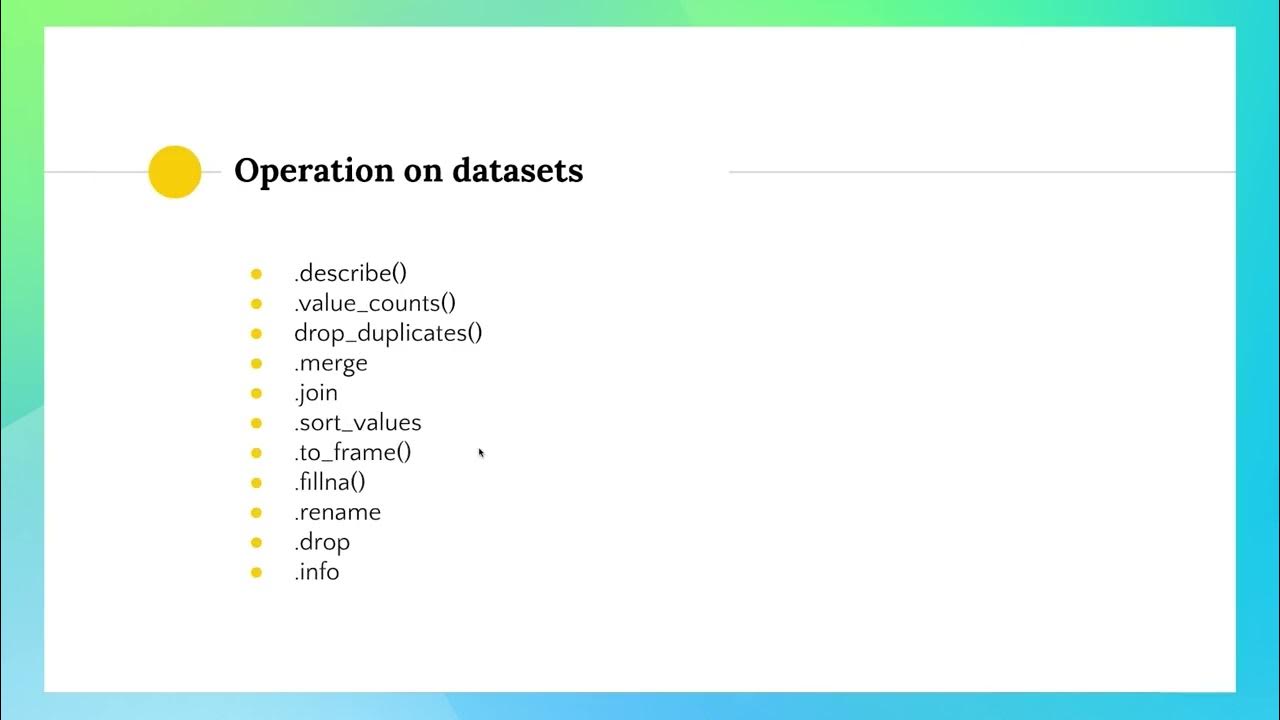Manipulação de Dados em Python/Pandas - #01 Conceitos Básicos
Summary
TLDRIn this video, Professor Samuel Martins introduces a comprehensive course on data manipulation with Pandas. The video begins with an overview of structured and unstructured data, explaining their differences and how they impact data storage and analysis. It dives into key data science concepts such as data frames, series, and the distinctions between independent and dependent variables. The professor also explains common terminology used in data manipulation and analysis, providing examples to help viewers understand how to work with real-world datasets. This is the first video in a series aimed at providing essential skills for working with data in Python.
Takeaways
- 😀 Pandas is an essential tool for working with structured data, and this course will focus on it for data manipulation.
- 😀 Data can be classified into two categories: structured data (easily tabulated) and unstructured data (such as images and videos).
- 😀 Structured data is generally smaller in size, making it easier to protect and manage, while unstructured data requires more space and specialized solutions.
- 😀 The course will focus on structured data, as it can be represented in tables or relational databases.
- 😀 A DataFrame in pandas is a two-dimensional structure representing a table, where each row is a record or observation.
- 😀 Columns in a DataFrame represent attributes or characteristics of each observation, and each attribute can be treated as independent or dependent variables.
- 😀 An index is used to organize rows in a DataFrame, typically numbered sequentially, although text labels can also be used.
- 😀 A single row or column in a DataFrame can be treated as a Series, which is essentially a one-dimensional list of values.
- 😀 Independent variables do not rely on others, while dependent variables are influenced by independent variables, such as how fuel prices depend on region and type of fuel.
- 😀 In statistics, 'population' refers to the entire set of data or observations, while 'sample' is a subset taken from that population for analysis.
- 😀 In data science, the term 'sample' refers to a single observation or record in a dataset, which is different from the statistical use of the term.
Q & A
What are the two main types of data discussed in the video?
-The two main types of data discussed are structured data and unstructured data. Structured data can be organized into tables with rows and columns, while unstructured data includes formats like images, videos, and documents that don’t fit neatly into tables.
What is the main focus of the course in terms of data manipulation?
-The course focuses on structured data and how to manipulate it using the Pandas library. It specifically deals with data that can be organized into tables, such as numerical data, dates, and strings.
How does the video differentiate between structured and unstructured data?
-Structured data can be organized into tables and is easier to store and protect. It typically includes numbers, dates, and strings. Unstructured data, on the other hand, includes data formats like images, videos, and text documents, which require more storage space and complex management solutions.
What is a DataFrame in Pandas?
-A DataFrame in Pandas is a two-dimensional table structure that holds data in rows and columns. It’s the primary data structure used in Pandas for data manipulation and analysis.
What is the purpose of the index in a DataFrame?
-The index in a DataFrame serves to uniquely identify each row. It can be automatically generated as integers starting from 0, but it can also be customized to use other data types like strings.
What are Series in Pandas?
-A Series in Pandas is a one-dimensional array that can be thought of as a single column or row from a DataFrame. It holds data similar to a list or vector.
What is the difference between dependent and independent variables in data analysis?
-Independent variables exist without being influenced by other variables, while dependent variables depend on the independent variables. For example, the price of fuel can be dependent on the state and type of fuel.
How is the term 'sample' used in data science, according to the video?
-In data science, a 'sample' refers to a single observation or data point within a dataset, which is typically represented by a row in a DataFrame.
How does the concept of 'population' differ in statistics and data science?
-In statistics, 'population' refers to the entire set of observations or individuals in a study, while in data science, 'population' can also refer to all the data points being analyzed. In contrast, a 'sample' in statistics is a subset of the population, while in data science, it refers to individual data entries.
What is the relationship between the columns and rows in a DataFrame?
-In a DataFrame, each row represents a unique observation or record, and each column represents an attribute or feature that describes those observations. Together, they form a structured dataset that can be analyzed.
Outlines

This section is available to paid users only. Please upgrade to access this part.
Upgrade NowMindmap

This section is available to paid users only. Please upgrade to access this part.
Upgrade NowKeywords

This section is available to paid users only. Please upgrade to access this part.
Upgrade NowHighlights

This section is available to paid users only. Please upgrade to access this part.
Upgrade NowTranscripts

This section is available to paid users only. Please upgrade to access this part.
Upgrade Now5.0 / 5 (0 votes)





